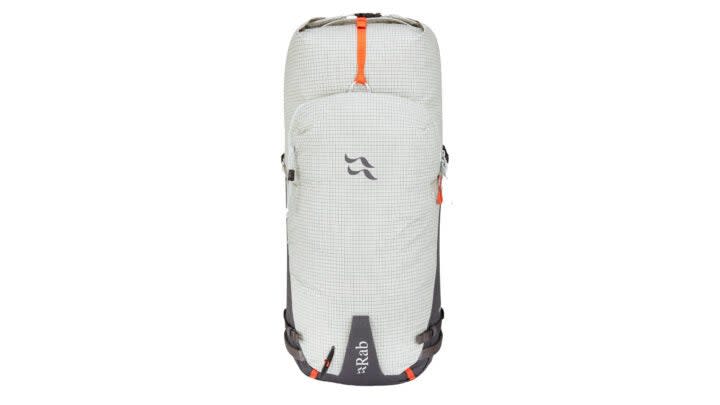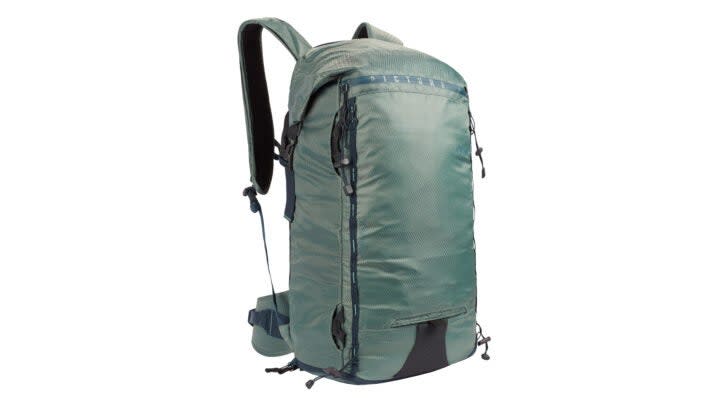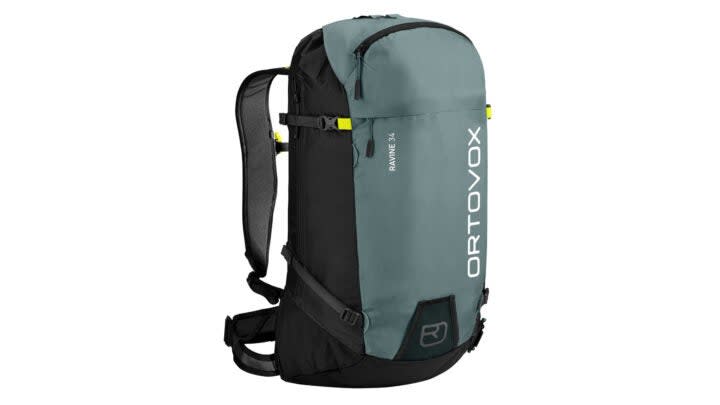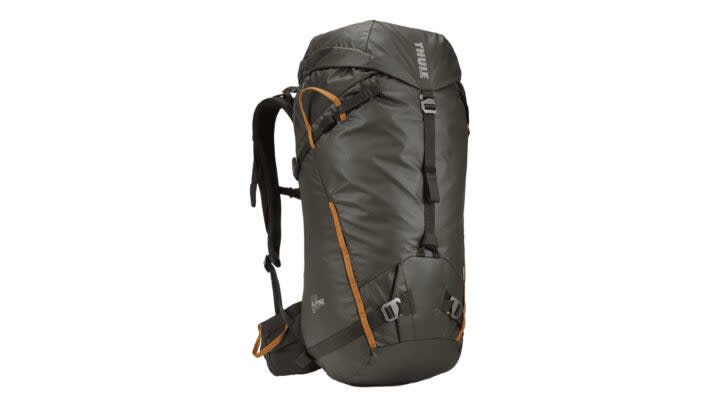The Best Backcountry Skiing Packs of 2024
This article originally appeared on Outside
Your backpack is your command center in the mountains, and in winter conditions, it ensures operations run smoothly. The best backcountry skiing packs are roomy enough to fit all of your essentials while keeping them both organized and accessible in a tight package that feels comfortable as an extension of your body. We took all of this into consideration while testing over a dozen backpacks specifically designed for backcountry skiing and alpine touring and rounded up the best picks for you below.
The Winners at a Glance
Video loading...
Best All-Around: Rab Khroma 38
Best In-Bounds: Gregory Verte 12
Best Use of Space: Picture Komit.Tr
Best Organizational Features: Ortovox Ravine 34/32S
Best Single Day Ski Mountaineering: Exped Couloir 30
Best Quiver Killer: Thule Stir Alpine
The Reviews: The Best Ski Packs of 2024
Rab Khroma 38 ($250)

Weight: 2 lbs 8 oz
Size: Unisex, One size 19in / 48cm
Dimensions: 61 x 31 x 29cm
Pros: The full back panel zipper opening and roll-top make for easy access and adjustments to the pack's size
Cons: Poorly-ventilated back panel
It may look like an alpine climbing pack at first glance, but this ultralight roll-top is stacked with smart features that enhance hut-to-hut ski missions and big line pursuits. Cinch it down for light loads or stuff it full of layers, food, and other gear--its wide hip belt didn't pinch our waists during tours when the pack was fully loaded down. With two compression straps on either side, plus a sternum strap that can be adjusted via toggles, it was easy to fine-tune the pack to change how it sat on testers' backs when they were changing configurations (the pack allows for A-frame and skimo ski carries, but not diagonal) for heavier loads. While the fit and range of carrying capacity makes this the ultimate do-it-all pack for all sorts of different missions, the Khroma's accessibility is what really sold our tester who used it for mellow ski touring and bigger ski mountaineering objectives in Colorado's Gore Range. "On a tour when I needed my small repair kit for skin glue, it was so easy to access the entire pack without having to unload everything," he said. "I could just open the full zip back panel and find the kit super fast." He also liked the external avalanche tool compartment and the large zippered hip belt pocket that made grabbing a snack on the go super smooth. One complaint was that the thick back panel didn't ventilate well, so this pack may not be the best option for spring tours in warm temperatures.
Bottom line: A great choice for skiers who want one pack for everything and the ability to carry a lot or a little with ease.
Picture Komit.Tr 26 ($160)

Weight: 2 lbs 15 oz
Size: Unisex, one size
Dimensions: 51 x 28 x 15 cm
Pros: Dry pocket at the bottom is good to keep wet items separate
Cons: No diagonal ski carry, only A-Frame
Our Central Colorado tester raved about this 26-liter pack's "Pandora's Box of features" that he used in conditions ranging from bluebird and above-freezing to blowing snow in single digits. The roll-top closure allowed him to expand and compress the bag as needed, while the zippered back panel made for easy access to the interior water bottle pocket and gloves. " I was on a tour in the West Elk Mountains where we skied three different lines and I must've transitioned from skinning to bootpacking to skiing a dozen times," he said. Thanks to the waterproof zip pouch at the bottom of the pack, he was able to keep his wet skins and crampons separate from the rest of his dry gear. "My layers would've been soaked if I had to throw them in the main compartment at each transition." Another 6-foot 2-inch, 200-pound tester was surprised by how well the pack fit. "For me, a pack this size can feel a little short on my back, but this one didn't. I appreciated how the sternum strap adjusted low enough to fit my chest." For wetter days or those in rugged, rocky conditions, the pack also boasts 210 Denier Ripstop nylon and PU coating made from 100 percent-recycled poly, recycled buckles and trims, and PFC-free DWR treatment.
Bottom line: The Komit.Tr 26 was designed for full-day ski tours when you want something light on your back and you'll be throwing skis on and off your pack during lots of transitions.
Ortovox Ravine 34/32S ($240)

Weight: 2 lbs 3 oz (men's 34L) / 2 lbs 2 oz (women's 32SL)
Size: 28-34 L (men's) / 26-32 S (women's)
Dimensions: 11.81 x 22 x 10"
Pros: Hyper-compartmentalized for easy organization
Cons: No hip belt pocket
Ortovox continues to lead the charge in ski pack innovation with this lightweight, framed pack that rethinks how ski gear should be carried. Two side zippers, one of which goes to the main compartment and the other to a separate compartment for quick access to skins, crampons, and gloves, gives you several organizational options. The main compartment, which has a drawstring closure, and the open avalanche tool sleeve are secured with a hook and webbing flap that's easy to open and close with a gloved hand. The brand also left no stone unturned with both a goggle and front panel pocket, ice axe loops, two carrying options for skis, hydration bladder pocket and tube access, and a helmet carry net. "The fit was perfect," said one tester who used the women's-specific 32 liter version. "I have a small torso and the back panel and straps felt very comfortable and secure, with a bunch of options for customizing the fit and an adjustable-height sternum strap." As with some packs that have many designated pockets (seven in total on this one), the Ravine doesn't leave a ton of space available in the main compartment, so best to use this for small and medium outings in moderate temperatures where you don't need a bunch of extra layers and other gear that takes up a lot of room.
Bottom line: This one's for all skiers who need all their gear to live in a very specific place and women who demand a snug, anatomical fit.
Exped Couloir 30 ($230)

Weight: 3 lbs 5 oz
Size: Back Length Range 18-21 in (men's), 17-20 (women's)
Dimensions: 12.2 x 22 x 8.7 in
Pros: Durable materials and balanced carry
Cons: Snow builds up in buckles
With a load limit of 29 pounds, the robust suspension and internal steel wire frame on this pack dispersed weight evenly, which allowed testers to comfortably strap skis and other technical equipment to the outside and still maintain a comfortable, balanced fit. That was key for our Jackson, Wyoming-based tester who used it on several big spring objectives in Grand Teton National Park where he found himself carrying some extra gear. "While I was skiing a line known as Chute Buck and faced with a steep, tight couloir and two rappels below me, the pack ensured that my rope, crampons, ice axe, and other gear for the day stayed tight to my back, allowing me to make precise turns as I descended into the unknown." Another tester praised the foam and tricot polyester back panel as both comfortable and effective at mitigating sweat on a hot springtime mission in Utah's La Sal Mountains. The 420 Denier Ripstop Nylon and EVA foam reinforcement on the front and base make this pack super durable. Other thoughtful details, including the beefy hip belt with two stretchy mesh pockets, 270-degree access through the back panel zipper, and brightly colored interior material that made finding smaller contents easy, seal the deal.
Bottom line: Smart storage solutions and carrying capacity make this pack ideal for single day ski mountaineering missions.
Thule Stir Alpine ($200)

Weight: 2 lbs 14 oz
Size: Unisex, one size
Dimensions: 11.42 x 10.24 x 22.83 in
Pros: Customizable features
Cons: No avalanche tool pocket
This pack can shapeshift into just about anything you want it to be, thanks to its smart design, a removable lid, frame sheet, hip belt padding, and sternum strap, all of which can shed up to 500 grams (1.1 pounds) for lighter, faster missions. "I was very grateful for the side-access zipper when the thing was filled to the brim with overnight gear for a snowmachine-accessed ice climbing festival up the Knik River Gorge," said our Alaska-based tester, who was able to use the side-access to get to gear without removing his climbing rope draped over the top of the pack. The streamlined body yet large 40-liter capacity makes it ideal for bigger trips and overnights requiring warm gear for cold temperatures. "The suspension had a perfect amount of padding for the capacity of the bag and even with a heavy load on the overnight trip, it felt great with no awkward pressure points," added the same tester after putting the pack to the test on ski mountaineering trips on Turnagain and Hatcher Pass. With little details like a storm flap to cover the pack when the lid is removed, a stretchy shoulder strap pocket for holding sunglasses or snacks, and gear loops on the hipbelt, this crossover pack is ready for anything from casual skiing to full-on mountaineering. One ding: the lack of an avalanche tool-specific compartment felt like the only oversight.
Bottom line: The Thule Stir Alpine is a versatile workhorse that can pull triple duty as a ski-, mountaineering, and even a climbing pack.
Backcountry Skiing Backpacks FAQ
How do I choose the right backpack for backcountry skiing and alpine touring?
1. Choose a backpack that fits your body.
Backpacks come in various sizes to accommodate different torso lengths, so measure the length of your spine from the base of you neck to the top of your hips and choose your backpack size accordingly. Backpack torso lengths generally range from 15 inches (size XS) to 20-plus inches (size L). Because fit is the biggest single factor in pack comfort and carry, we recommend going into your local gear shop wearing the layers you plan to tour in and trying the packs on for size. The hipbelt should securely wrap your iliac crest, and the back panel shouldn't hit you in the back of the head when you have a helmet on
2. Choose a backpack that suits your skiing adventure.
If half-day backcountry tours are your norm, choose a lower volume pack (20L-30L) that fits just the essentials (shovel, probe, water, extra layers, snacks). If you typically spend full days in the backcountry, you'll want a higher volume pack (30L-40L) that fits extra supplies for the extra time you'll be spending out in the elements. Also make sure that your avalanche shovel easily slips in and out of the dedicated avy pouch, and that the pack is both big enough and sufficiently organized for your touring preferences. Don't be afraid to size up to a larger pack capacity if you're on the fence about how much space you'll need--a few extra liters of empty space won't weigh you down that much. If you'd like to be able to secure your skis to your pack, look for a pack with an A-frame or diagonal ski carry strap system. The same goes for your helmet: some packs have integrated helmet-carry systems.
What should I pack for backcountry ski days?
Always carry avalanche safety equipment when traveling in the backcountry. That includes wearing a beacon and carrying a shovel and probe in your pack. You'll also need extra layers, a helmet, sufficient hydration (it's a good idea to carry some hot liquid for longer backcountry adventures), energy snacks, a first aid kit, and a multi tool.
How We Test
Number of testers: 22
Number of products tested: 14
Number of vertical feet climbed: 600,000
Number of beers carried in a pack up Highland Bowl on closing day: 12
Number of times our lead tester's wife asked him to carry more stuff "because you have extra room in that fancy pack": 5
To nail down the best ski packs of 2024, we seeded 14 products to 22 different testers according to their planned objectives for the season, body and skier type, and appropriate testing environments. Then, we set testers loose in the mountains, largely in the Continental U.S. (Colorado, Utah, Jackson Hole, and Alaska), where many states received historic snowfall this past season. Testers jammed gear into packs, stuffed them shut, and put the packs through both rugged and mellow ski ascents and descents.
We focused on newly-designed packs with practical, ski-specific features that make traveling on snow easier, safer, and more enjoyable. Comfort is a must, even for packs meant to carry smaller, lighter loads, as is durability, so we asked testers to evaluate straps and back panels and hip belts alongside the quality of materials used. After every time a pack was taken out, testers filled out feedback forms assessing fit, weight distribution, ease of access, even pocket size and placement. Testers noted how easy it was to find what they needed, transition in the skin track, and carry their skis and boards on their back up steep couloirs. After this rigorous testing process, the following six packs emerged as the cream of the crop.
Meet Our Lead Tester
Scott Yorko is a former gear editor for Backpacker, SKI, TransWorld SNOWboarding, and Outside. He lives on the edge of West Central Colorado, where he splits his ski time between the world-class resorts around Aspen and backcountry terrain of the West Elk Mountains. He loves to chase storms and visit pow-shredding friends, many of whom tested this year's crop of ski packs, in places like Alaska, Jackson Hole, the Sierras, Utah, and all throughout Colorado.
More from the 2024 Winter Gear Guide
The Best Backcountry Skis of 2024
The Best Backcountry Ski Boots of the Year
The Best Winter Hiking Boots of the Year
For exclusive access to all of our fitness, gear, adventure, and travel stories, plus discounts on trips, events, and gear, sign up for Outside+ today.

